| |
|
|
| |
You learn something every day.
Mon 5th December, 2011
|
|
|
|
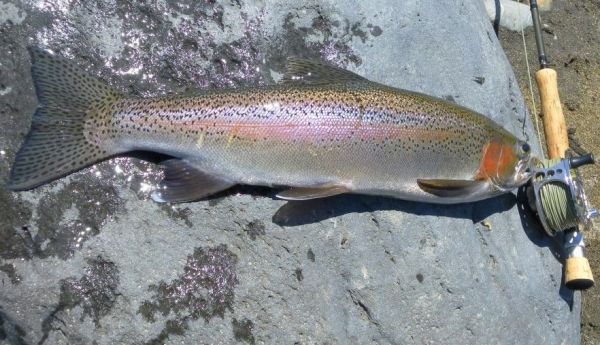
The old saying "you learn something every day" is never more true than when applied to fishing.
I had picked up long time mates Rosemary and Alex from Creel Lodge and we were making our way along the track to a quiet spot upriver. I'd better explain that Rosemary is a Kiwi and Alex lives in Seattle. Both are biologists and they met years ago while working on a project in Chicago.
This was Alex's first trip to visit his old work colleague and even though he was only half way through his two week trip he was already smitten with New Zealand.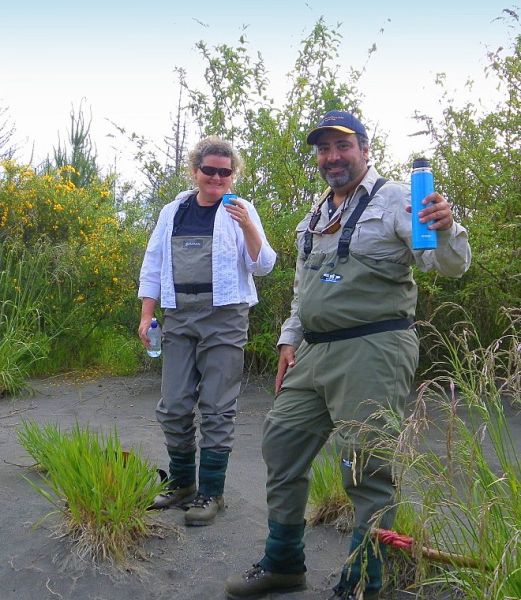
Our walk upriver had turned into a bit of a nature ramble with Rosemary pointing out plants and insects that her biologist buddy may not have come across before ... but it was when she showed Alex a shrub called a " Tut " that my ears pricked up. This particular plant interests me because it has a notorious connection with the Passion Vine Hopper. Until now I wasn't sure what the plant looked like but now I knew. According to Wikipedia its one of several belonging to a family called Coriaria and Rosemary explained that most parts of it are poisonous. She recounted an incident where four friends were camping way out in the bush. Apparently it looks very similar to another plant, the leaves of which can be brewed up to make a tea. Luckily one of the four didn't drink tea, because they had got it badly wrong and picked leaves from the coriaria. Fortunately he was able to get them that much needed help.
The common name for it in New Zealand is the Tutu which has a Maori origin. It contains the neurotoxin tutin which is where our little fiend the vine hopper comes in. This small sap-sucking terrestrial can be found covering plants all along the river in summer. When it feeds on the Tutu plant it produces honeydew which foraging bees gather, unknowingly contaminating their honey with the toxin. So far only a few areas of New Zealand have been identified as high risk places where toxic honey has frequently turned up.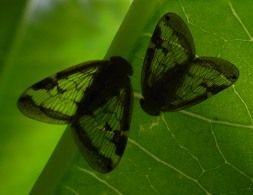 Beekeepers there have to closely monitor Tutu spread and passion hopper populations within Beekeepers there have to closely monitor Tutu spread and passion hopper populations within
3 km of their apiaries. The last recorded death from eating contaminated honey was in the 1890's but there are still non fatal poisonings from time to time. What puzzles me and please excuse my ignorance, is that we know there are probably millions of vine hoppers covering plants all along the Tongariro in summer. Some of them will have been sucking the sap of the " Tut " I can only guess the insect is immune to the poison. Anglers know only too well how frustratingly preoccupied trout can become when feeding on vine hoppers ... so why aren't the fish affected?
If anyone out there knows the answer I'd love to hear from you. Neither friends had fished before so we found a backwater with plenty of room, explained some of the basics and had them both practicing a simple pick up and lay down cast. Alex was keen to try nymphing with the indicator so we went back onto the main river and after adding mending to the list he was doing ok. Meanwhile Rosemary elected to fish the broken water upstream and at the very end of a drift, just as the flies began to lift, the cicada went under as a trout grabbed the small Pheasant Tail. No one expects to catch many fat silver rainbows at this time of year but for this new angler it didn't matter anyway. The grin on her face as she landed this monster kelt said it all and after Alex took a couple of pics it was released safe and sound to fight another day. Four and a half hours on the river never seems like long to me but this half day flew by...thanks guys.
We didn't see that many fish during the morning but those that we did spot would have been difficult to call with out the aid of our polaroids. I had always assumed that sunglasses were probably invented a couple of hundred years ago but it turns out their history goes way back further than that. Ancient Inuit people used a form of eye protection which looked very much like contemporary sunglasses. They carved them from wood or walrus ivory which was flattened, then shaped and had a slit cut in each “lens.” These slits not only allowed them to see out but also reduced the amount of reflected sunlight from the snow and ice helping to prevent damage to their eyes.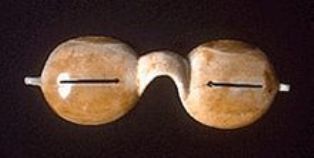 There are records that show the Chinese utilized flat panes of quartz to help relieve their face and eyes from the glare of the sun and Judges in Chinese courts also used them to hide their facial expressions while questioning witnesses. The Roman emperor Nero is reported to have enjoyed watching gladiatorial fights looking through a couple of emeralds. I doubt this gave any actual eye protection and was probably more of a novelty thing to enhance the spectacle { I know }. In the middle of the 18th century an English optician James Ayscough experimented with green or blue tinted lenses not to shield the eyes from the sun but because he believed they could help correct certain problems with vision. These fist tinted spectacles are believed by many to be the fore-runners of modern sunglasses. We can thank the movie stars of the early 1900’s for popularizing the wearing of “shades”. There are records that show the Chinese utilized flat panes of quartz to help relieve their face and eyes from the glare of the sun and Judges in Chinese courts also used them to hide their facial expressions while questioning witnesses. The Roman emperor Nero is reported to have enjoyed watching gladiatorial fights looking through a couple of emeralds. I doubt this gave any actual eye protection and was probably more of a novelty thing to enhance the spectacle { I know }. In the middle of the 18th century an English optician James Ayscough experimented with green or blue tinted lenses not to shield the eyes from the sun but because he believed they could help correct certain problems with vision. These fist tinted spectacles are believed by many to be the fore-runners of modern sunglasses. We can thank the movie stars of the early 1900’s for popularizing the wearing of “shades”. Most people believe it was originally to help avoid being recognized by adoring fans. Most people believe it was originally to help avoid being recognized by adoring fans.
But another equally plausible explanation was their constant exposure to the powerful arc lighting that had to be used because of the slow speed film in use at the time. After a day on set most of the actors were left with pretty sore, reddened eyes and dark glasses were a good way of hiding this. By the 1920’s sunglasses had become a must have fashion accessory and Sam Foster began mass producing them under the name Foster Grant in New Jersey. The first polarized lenses appeared around 1936 and were invented by the scientist Edwin Land. In 1937 he co-founded the Polaroid Corporation and although their early success revolved around sheet polarizing filters for sunglasses, during World War II they applied the new technology to military equipment such as target finders, the first smart bombs and a viewing system called Vectograph which helped reveal enemy positions when filmed from the air. In 1947 he demonstrated the first instant camera which eventually became hugely popular world-wide.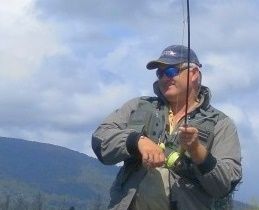 Sportsmen were the first to discover the advantages of polarizing sunglasses but nowadays more and more people are wearing them for everyday use. Every pair I have are polaroids and all anglers appreciate the benefits from using them to reduce glare when fishing and to protect the eyes from injury from hooks etc. Spotting and stalking fish would be much more difficult without our polaroids. Sportsmen were the first to discover the advantages of polarizing sunglasses but nowadays more and more people are wearing them for everyday use. Every pair I have are polaroids and all anglers appreciate the benefits from using them to reduce glare when fishing and to protect the eyes from injury from hooks etc. Spotting and stalking fish would be much more difficult without our polaroids.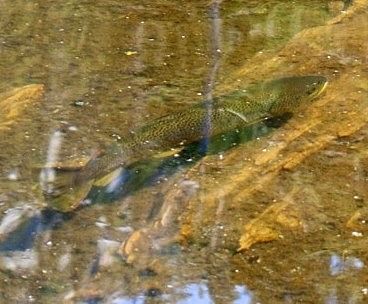
When light strikes a reflective surface it becomes polarized which means the photons begin vibrating in one direction instead of randomly. This not only distorts the color of objects but causes a mirror-effect which makes it almost impossible to see anything below the surface of the water. Polarizing sunglasses filter the light waves by absorbing some of this reflected glare while allowing other light waves to pass through. Most of this reflected light is in the horizontal plane so a polarized lens is mounted vertically in the frame and acts a bit like an up ended venetian blind. This prevents most of the horizontal light from reaching the eye but allows the vertically polarized light through enabling the angler to see below the surface.
The right lens color for the conditions can also benefit the fly fisherman when spotting trout :
Amber lenses help with contrast and color distinction which make the outline of a fish stand out from its surroundings but they don’t always provide the best protection from the full glare of the sun.
Copper tints are generally accepted as a better choice because they give even greater color and contrast enhancement and absorb more of the blue light rays which cause glare. So in most conditions this makes them an excellent choice for fish spotting.
Yellow is useful in shallower water and on overcast days. In low light conditions it utilizes all the available light to help enhance contrast but can increase color distortion.
Grey is a good general purpose choice providing true color definition, good depth perception and at the same time fights full sun glare.
I’m an absolute shocker with sunglasses and have lost count of those I’ve sat on…stepped on ... or watched float off downriver. Nowadays I routinely carry two pairs, one with grey lenses the other copper. These two colors will cover most conditions…and when the inevitable happens I still have a back-up pair !
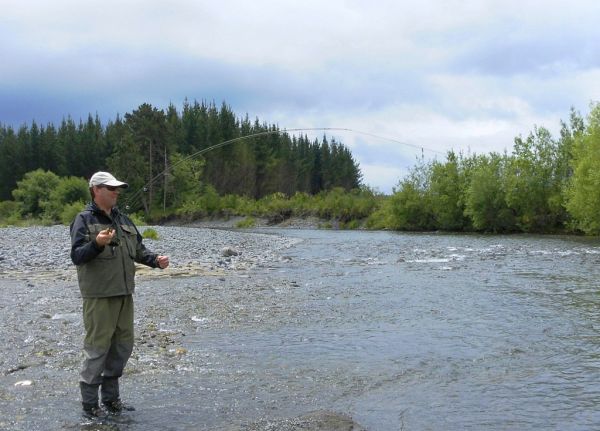
Next day I met fishing buddies Warwick and Brendon at the coffee cart. Warwick hadn't fished the Tongariro for a number of years and I remember smiling during the first exchange of emails when he wrote that " he would prefer to get away from the crowds ". Except for the Bridge Pool its been a while since I've seen anything resembling a crowd on The Tongariro. Brendon re-located from Oz to this much better place around a year ago and had never fished using the indicator. So there was a quick change of plan and we decided to start in Judges. Its a great place to get someone used to fishing with an indicator, plenty of room to cast, a reasonably slow drift and the perfect stretch to demonstrate mending. On the way up we spotted the unmistakable shape of a nice brown lying doggo in the gin clear water of the Lonely Pool. We couldn't pass this up but before the leader had even landed on the surface he was off, disappearing into the shadows of the cliff.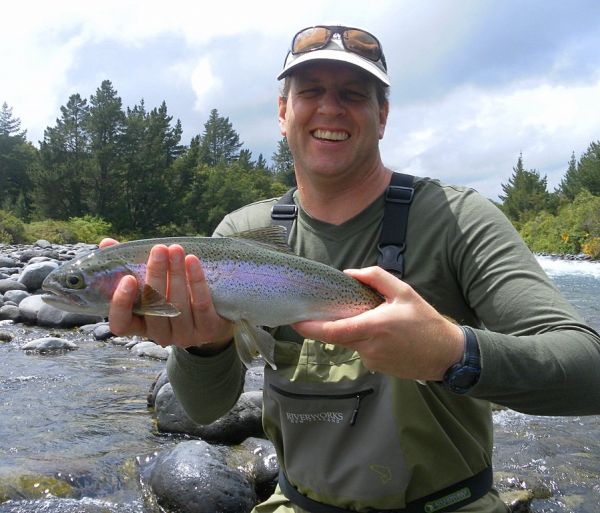 We spent the time in Judges getting them used to upstream nymphing although neither had ever fished with the long dry and dropper before so every now and again they would change over. Warwick had a couple of hook ups but lost both fish only getting a scale on the hook for his efforts. The day had started overcast and cool with drizzly rain but by the time we got into Boulder the sun was already poking through and we were all peeling off the layers. Warwick grabbed the indicator rod and fished the tail up, while Brendon went for the dry and dropper set up at the top of the pool. After pointing out some of the more likely spots the cicada eventually dipped as he drifted it past a large boulder. We spent the time in Judges getting them used to upstream nymphing although neither had ever fished with the long dry and dropper before so every now and again they would change over. Warwick had a couple of hook ups but lost both fish only getting a scale on the hook for his efforts. The day had started overcast and cool with drizzly rain but by the time we got into Boulder the sun was already poking through and we were all peeling off the layers. Warwick grabbed the indicator rod and fished the tail up, while Brendon went for the dry and dropper set up at the top of the pool. After pointing out some of the more likely spots the cicada eventually dipped as he drifted it past a large boulder.
He was into his first New Zealand rainbow, he told me after he was praying it wouldn't get away.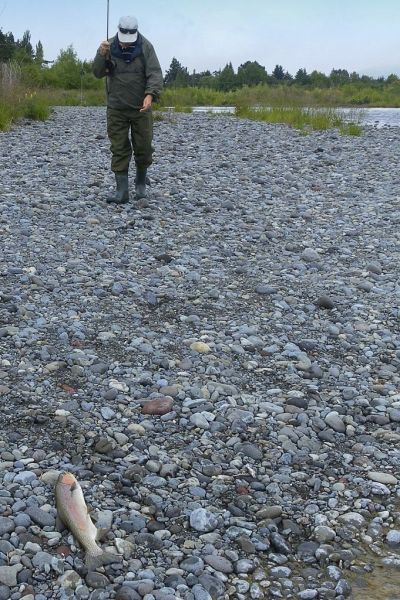
This hen actually gave a pretty good account of itself and as he slipped it back into the river he was still smiling. Warwick was also getting some interest but he just couldn't connect so they decided to change around. Ten minutes later Brendon struck at another fish again with only a scale to show for it. But he did hook up next cast...himself...with a nymph embedded deep in his back. When you also have a layer of clothing between you and the problem hook they are always a bit more difficult to remove. As long as you are confident with the procedure its still quick and fairly pain-less...I know I didn't feel a thing. Brendon must be a bit of an attention seeker because a few casts later he did exactly the same thing again. This time he had missed another take and tried to recast with too much line out.
I didn't tell him that as I was preparing to yank out the nymph I noticed there was a bloody great fish scale still on the hook. He went a little pale after I pulled it out because when I showed him the fly he thought it was a piece of his back ! The clouds began to gather so we decided to get back to the truck for a beer and lunch while it was raining. Next stop was the Braids, I hadn't been there for a while but even though the heavy showers had stopped we had the place to ourselves. Warwick fished the shallow Stones and landed three out of four all on small Pheasant Tails. His mate hooked up in the Plank and had a great scrap with a barely legal trout that thought it was a three pounder. We did the whole circuit and poor old Brendon lost another after it jumped a few times and spat the hook. Our last couple of chances came above the Honeypot but they weren't to be. What I haven't mentioned is that both these anglers have a very special talent. If their reading this they'll be having a bit of a chuckle because they know whats coming. They tie the most intricate knots I've ever seen...its a pity they tie them all while casting. I've never used so much line in one day. On the bright side I can now re-rig a rod, undo tangles and tie on flies twice as fast as I used to...even with my eye-sight. Thats what I mean "you learn something every day".
After the heavier showers early in the week the river level rose a little but not enough to make any real difference. Anglers fishing into darkness report plenty of hatches, especially caddis. If your out and about almost anywhere on the river you will likely be talking to yourself. When the sun is shining I'd probably give the middle part of the day a miss and have a kip on the riverbank.
The coming weeks will see more and more pics of browns on the web-sites and I've no doubt there will be some great fish caught this year.
Tight lines guys
Mike. |
|
|
| Back to Top |
|
|
|
|
|
|
|